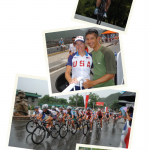After those mishaps, I saw a horrible crash of the German women’s two-person bobsled team, which lost control going about 90 miles an hour. The brake person ejected while the driver stayed in the sled careening upside down along the narrow chute of ice. Horror showed in the faces in the crowd as well as the other sledders as they watched this harrowing event.
In the figure skating, the men and the women fell all over the place. I watched a French man try a quad jump, apparently an important display of athleticism for the men for whom artistry is not enough. Smack to the ice he went, breaking his confidence and perhaps a small patch of cartilage or bone. In the short-track speed skating, two of the leaders got tangled up and went careening into the wall. In the aerials, it seemed that the finale of the big tricks was a horrific tumble.
Even the ads showed falls, with a spot for Visa featuring poor Dan Jansen falling in the 500-meter race in 1988 just after his sister died from leukemia. Fortunately, Jansen came back to win in 1994 in Lillehamer, Norway, the scene of his triumph providing the viewer a reason to feel good about the world and start charging Caribbean vacations with that magic piece of plastic.
Sports is great fun, but it causes an incredible amount of injury for fine young people who, in a few years, will show up in the offices of rheumatologists and orthopedists with chronic pain from post-traumatic osteoarthritis.
Time to Dial Down the Danger?
While the Winter Games are always a dangerous place, it seems that the powers that be want to make them even more dangerous, perhaps to sort out the best athletes or to garner more viewers who like sport to teeter on the edge of catastrophe for the participants. The hills were made steeper, the ice slicker, and the sports themselves more prone to injury. Four wild men bombing down a narrow course in the ski cross is simply asking for trouble.
Watching the women’s giant slalom in a dense fog where the skier could see only a few gates ahead, I had to ask myself, Where are the adults in this activity? Doesn’t anyone care that athletes can get seriously injured or killed when the conditions get too bad or the courses get too steep? Sadly, this Olympics witnessed a fatality when a Georgian luger died during training. In the aftermath, one of the men’s bobsled teams decided not to compete because of their worries about safety. Of course, in the headlines on CNN, these athletes were called “quitters” for making a reasonable decision.


